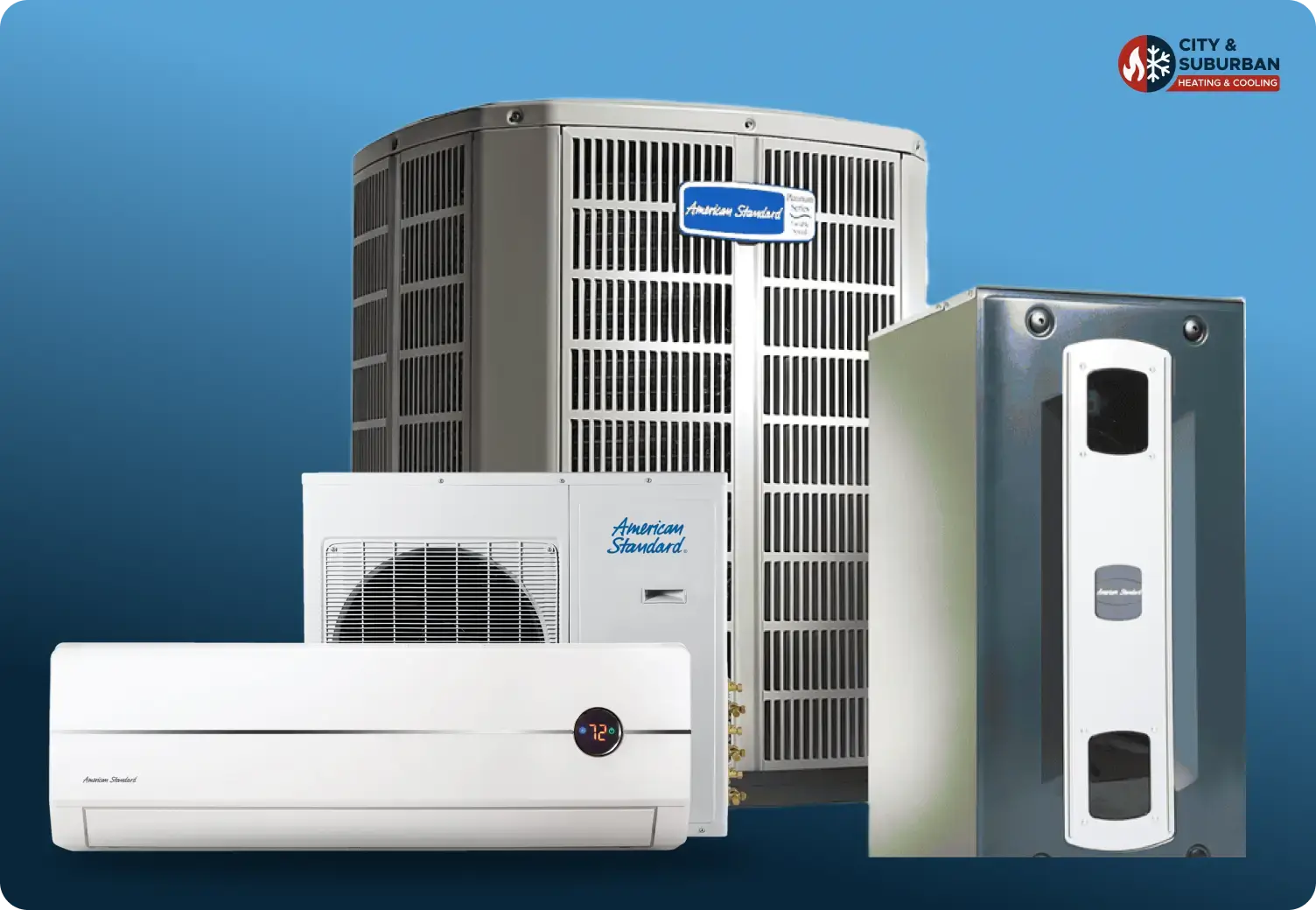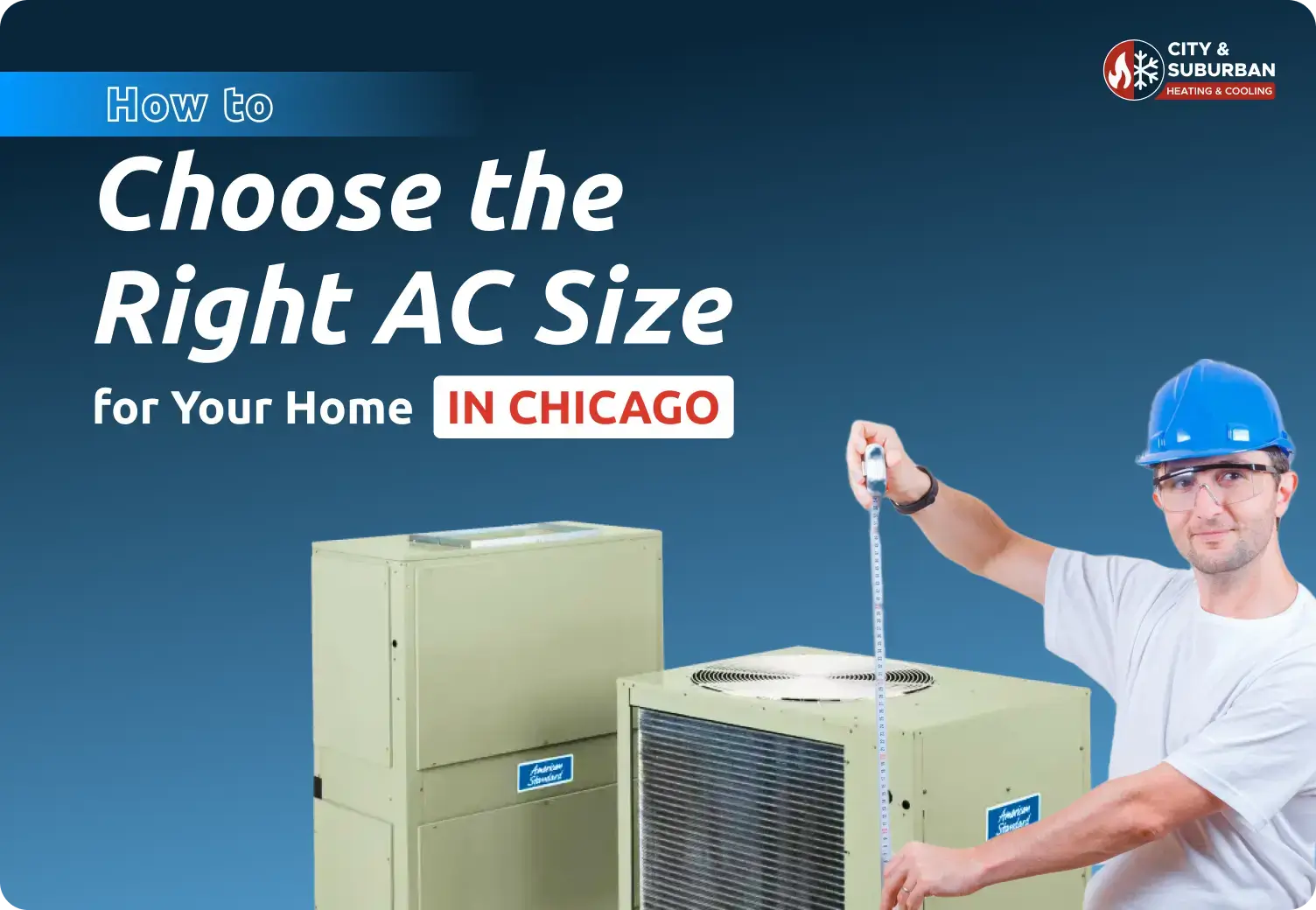Feeling overheated in your Chicago home every summer? Getting the right air conditioner size can be the secret to turning your home from a stuffy space into a refreshing escape from the heat. The goal isn’t just about picking any AC that fits, it’s about choosing a unit that’s exactly right for your unique space and Chicago residents, knowing the right size helps avoid air quality problems. The perfect-sized AC keeps you comfortable, helps you save on energy bills, and ensures your system lasts longer.
In this easy-to-follow guide, you’ll learn what size AC is best suited for your home. We’ll walk you through the process, making it simple to keep your living space cool and comfy all summer.
1. Understanding AC Sizing
When selecting an AC,AC size refers to its cooling capacity, typically measured in BTUs (British Thermal Units) or tonnage.Choosing the rightair conditioner size for your house ensures efficient cooling without excessive energy usage.
- 1 Ton = 12,000 BTUs of cooling power.
- The higher the tonnage, the more cooling capacity the AC unit has.
For example, a 1-ton unit is suitable for smaller rooms, whereas a 2-ton AC unit is ideal for larger spaces, like a 2000 sq ft house.
Why Is AC Sizing Important?
-
- Efficiency: An undersized AC unit will struggle to cool the room, using more energy. An oversized unit cools too quickly and doesn’t dehumidify properly, which can lead to discomfort and higher humidity.
- Cost savings: The right-sized air conditioner unit reduces energy bills and prevents overuse of your air conditioner, increasing lifespan.
2. How to Choose the Right AC Size

Here’s a simple, step-by-step guide to help you choose the right AC size for your home:
Step 1: Measure the Length and Width of Your Room in Feet
- Start by measuring the length and width of your room in feet.
Step 2: Calculate the Required BTUs
- Multiply the room’s square footage by 25 to get the recommended BTUs for cooling.
Step 3: Adjust for External Factors
- Add 10% more BTUs for rooms with high sun exposure or large windows.
- Add 10% more BTUs for poorly insulated rooms.
- Add 600-800 BTUs for each additional person in the room.
Step 4: Choose the Right AC Type
- Depending on the room size, decide between window AC units, split systems, or central air conditioners.
Step 5: Check SEER Rating
- Look for a high SEER rating to ensure energy efficiency, which reduces long-term energy costs.
Step 6: Consult a Professional
- For accurate sizing and installation, consider consulting an HVAC professional.
3. BTU Calculator: How to Estimate Your AC Needs
Looking to find the best AC unit for your home in Chicago? Understanding how to calculate BTUs (British Thermal Units) is a great first step. The formula for estimating the right cooling capacity is simple and can help you narrow down the proper air conditioner size for your space.
Formula: BTUs Required = Square Footage × Cooling Factor
The cooling factor depends on how your home retains or loses heat:
| Home Condition | Cooling Factor (BTU Per Sq. Ft.) |
|---|---|
| Well-Insulated, Shaded Home | 20–25 |
| Average Insulation And Sun | 25–30 |
| Poor Insulation Or Heavy Sun | 30–35 |
If you live in a 1,500 sq. ft. Chicago home with average insulation, here’s how to do the math: 1,500 sq. ft. × 25 BTU = 37,500 BTUs. That equates to roughly a 3 ton AC unit (since 1 ton = 12,000 BTUs).
Using this BTU calculator gives you a ballpark figure for your HVAC sizing in Chicago. However, it’s best used as a guide—not a guarantee. For reliable performance and long-term savings, always follow up with a Manual J HVAC load calculation performed by a licensed local expert.
4. Energy Efficiency: Why It Matters
Energy efficiency is key when selecting an air conditioner for your home, especially if you plan to use it during long summer months in Chicago. Here’s why you should prioritize it:
- Lower Utility Bills: Energy-efficient AC units use less energy to cool the same amount of space, which translates to lower monthly electricity bills.
- Environmental Benefits: Choosing an energy-efficient air conditioning unit reduces the overall carbon footprint, making it a more eco-friendly option.
- SEER Rating: The Seasonal Energy Efficiency Ratio (SEER) indicates how efficiently an AC unit operates throughout a cooling season. A higher SEER means the unit is more energy-efficient, so look for units with a SEER of 14 or higher for maximum savings.
5. Choosing the Right Type of AC
Choosing the right type of AC depends on the size of your space, the number of rooms you need to cool, and your budget. Here’s a breakdown:
- Window AC Units: Ideal for cooling small rooms (up to 600 sq. ft.). They’re affordable and easy to install but may not be as efficient for larger spaces.
- Split Systems: These systems are quieter and more efficient, suitable for larger spaces (600-1,200 sq. ft.). They require professional installation but offer better overall performance.
- Central Air Conditioning: Perfect for homes that need whole-house cooling. Although installation costs are higher, central AC systems provide uniform cooling and are the best choice for larger homes or homes with multiple rooms.
6. Common Mistakes to Avoid
Choosing the wrong AC size can lead to inefficiency and higher costs. Here are some common mistakes to avoid:
- Underestimating Cooling Needs: If your AC unit is too small for the room, it will run constantly, increasing your energy costs and reducing the lifespan of the unit.
- Choosing an Oversized Unit: An oversized AC cools quickly but doesn’t properly dehumidify the air, leading to humidity problems and uneven cooling.
- Skipping Regular Maintenance: Even the best air conditioning systems can lose efficiency without regular maintenance. Make sure to clean the filters, check refrigerant levels, and schedule regular inspections.
- Ignoring Insulation and Sun Exposure: Poor insulation leads to heat gain, which means your AC unit needs to work harder to cool your space. Before buying an AC unit, ensure your room has good insulation or consider improving it.
7. Considerations for People Count in AC Sizing
The number of people in a room affects the AC’s cooling capacity. More people generate additional heat, which means your AC needs to work harder to maintain the desired temperature.
- For each extra person, add 600-800 BTUs to your calculation. If you regularly host guests or have a large family, consider this when selecting your AC unit.
8. Home Square Footage and Air Conditioner Size (Tons)
To make it easier for you to determine the correct AC unit size for your home, here’s a helpful table:
| Home Square Footage | Air Conditioner Size (Tons) |
|---|---|
| 100 – 400 Sq. Ft. | 1/2 Ton |
| 400 – 600 Sq. Ft. | 1 Ton |
| 600 – 800 Sq. Ft. | 1.5 Tons |
| 800 – 1,000 Sq. Ft. | 2 Tons |
| 1,000 – 1,200 Sq. Ft. | 2.5 Tons |
| 1,200 – 1,400 Sq. Ft. | 3 Tons |
| 1,400 – 1,600 Sq. Ft. | 3.5 Tons |
This table gives you an easy reference for the approximate AC unit size needed based on your home’s square footage. Adjust for factors like sun exposure and insulation as necessary.
9. Conclusion
Choosing the right AC size for your home is essential for maintaining a comfortable indoor environment and ensuring energy efficiency. By carefully considering factors like room size, insulation, and the number of people in your home, you can select the perfect AC unit. Energy efficiency, in particular, should be a priority to save on long-term costs and reduce your environmental impact.
If you are still unsure about the right choice, it’s always a good idea to consult with a professional HVAC technician to make sure your AC system meets your needs.
10. Frequently Asked Questions (FAQs) on AC Sizing in Chicago
1. How do I calculate what size AC I need?
To calculate your AC size, multiply your home’s square footage by a cooling factor (usually 20–35 BTUs per square foot, depending on insulation and sun exposure). For example, a 1,500 sq. ft. Chicago home with average insulation: 1,500 × 25 BTUs = 37,500 BTUs → roughly a 3 ton AC unit
2. What is the $5000 AC rule?
The $5000 rule helps decide whether to repair or replace your AC. Multiply the cost of repairs by the unit’s age. If the result exceeds $5,000, replacement is generally recommended. Example: $400 repair × 15-year-old unit = $6,000 → consider replacing your system.
3. Will a 2-ton unit cool a 1500 sq ft house?
It might, but not ideally. A 2-ton unit (24,000 BTUs) typically covers 1,000–1,300 sq. ft. For a 1,500 sq. ft. Chicago home, especially one with average insulation, a 2.5 to 3 ton unit is more appropriate for consistent comfort and energy efficiency.
4. How many sq ft does a 3-ton AC unit cover?
A 3-ton AC unit (36,000 BTUs) typically cools 1,400 to 1,800 sq. ft.—ideal for medium to larger Chicago homes with average insulation. Always factor in your home’s layout, insulation quality, and exposure to sunlight for a precise match.




